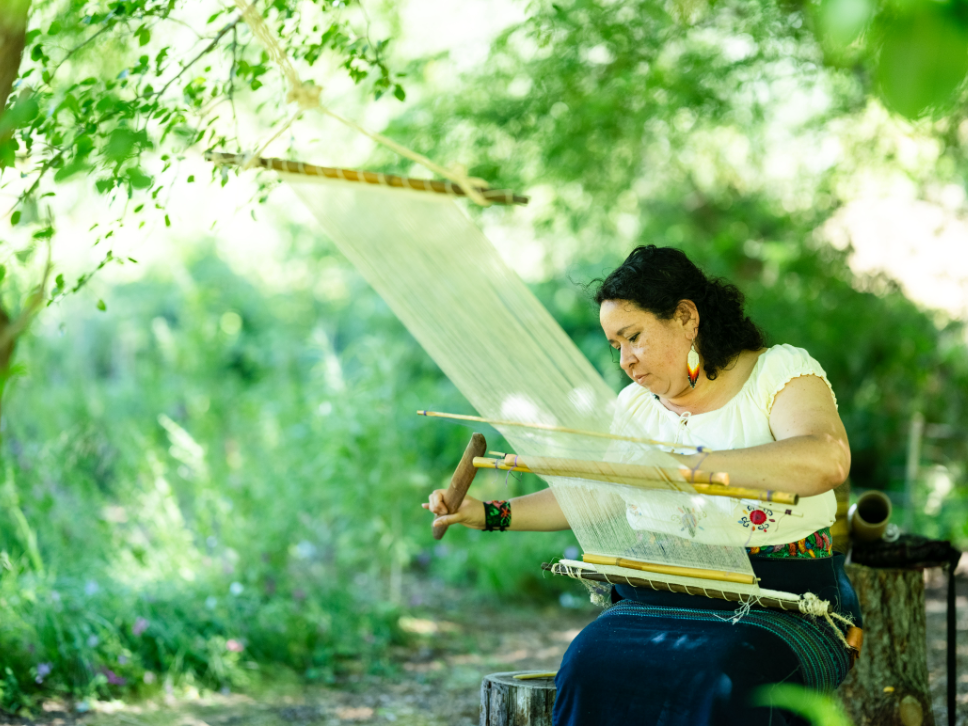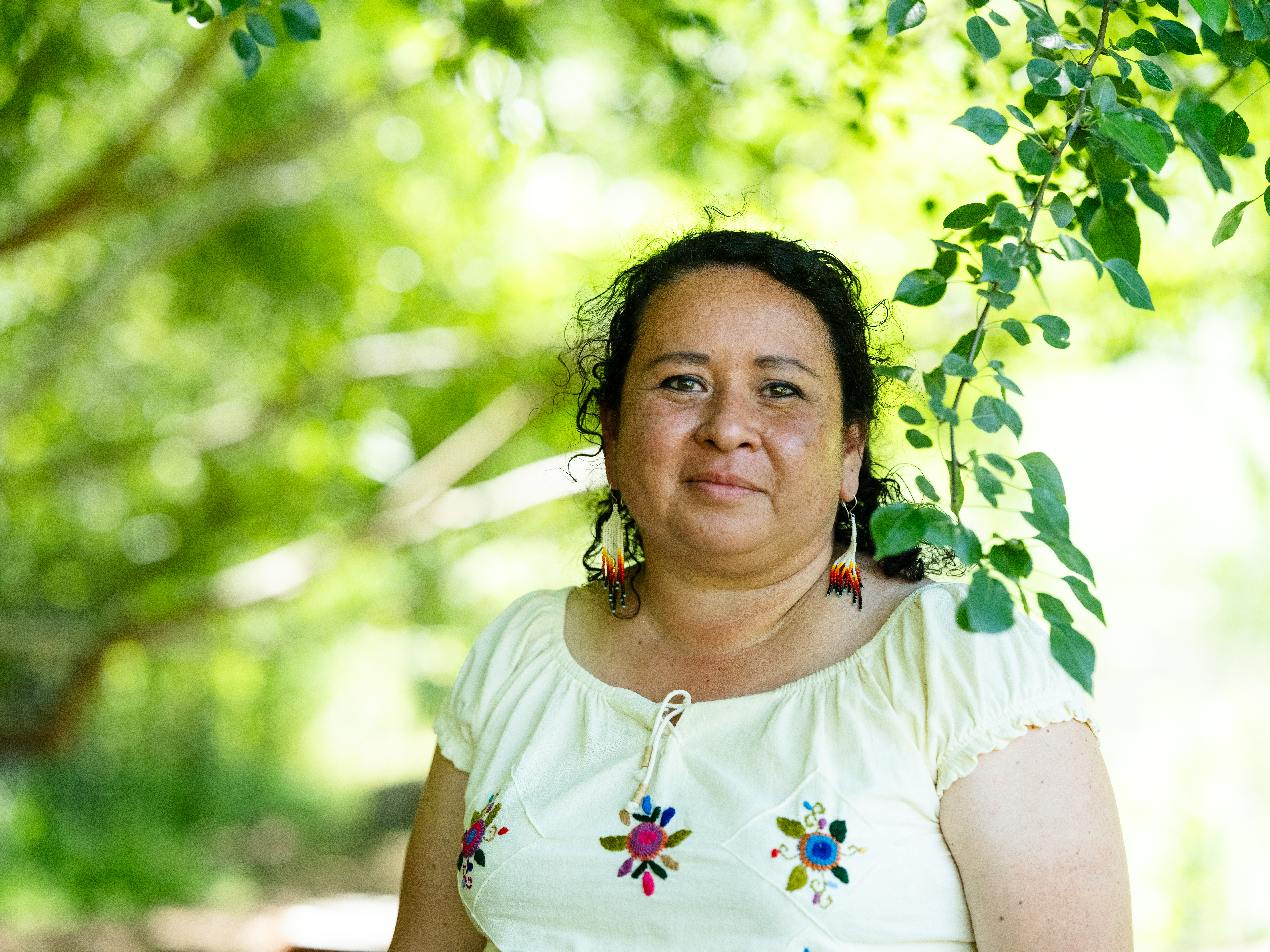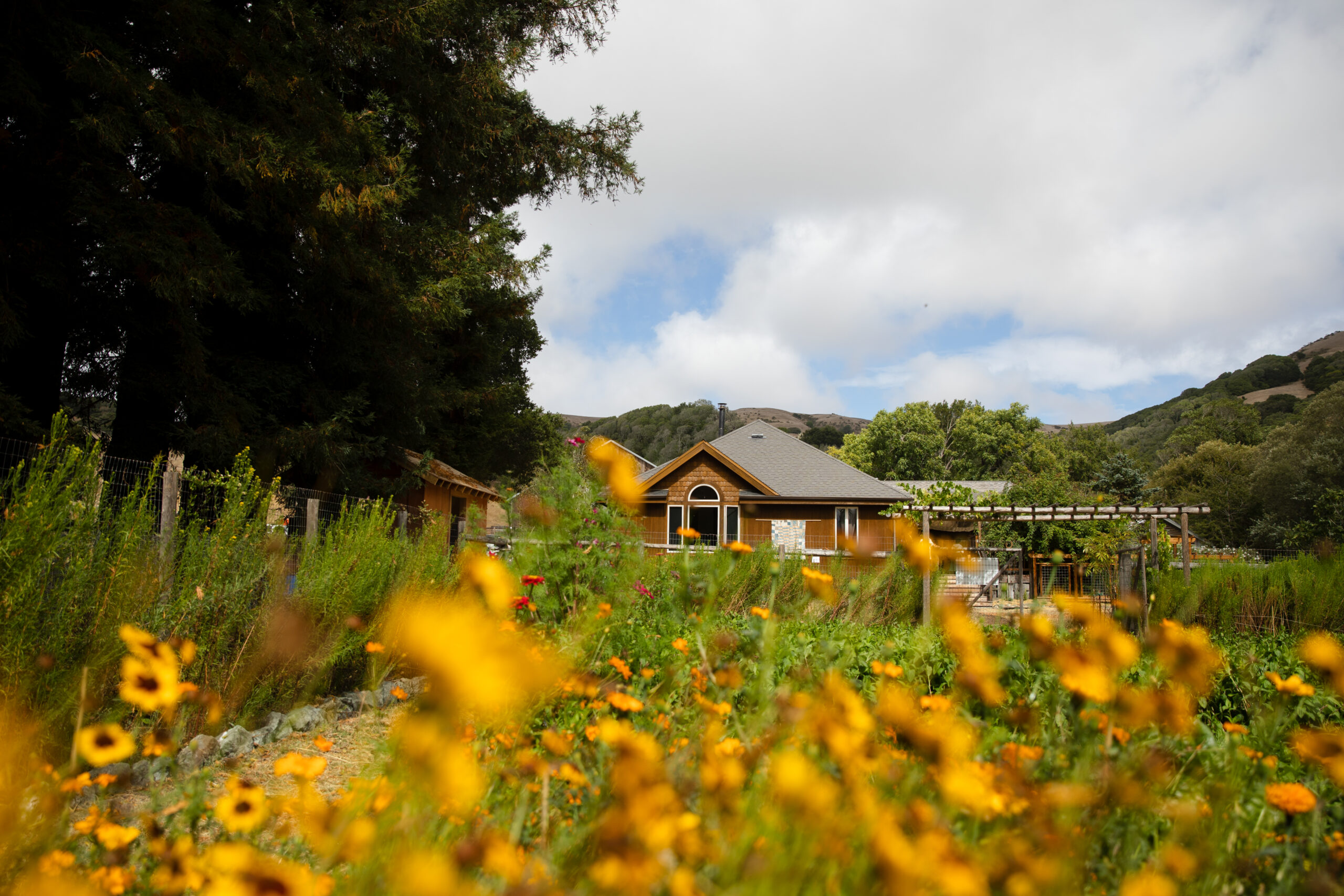Written by Stephany Wilkes. Photographed by Paige Green.

Sari Monroy Solís is a Mayan Kaqchikel and Xicana weaver, teacher, dyer, herbalist-in-training, and Fibershed’s Learning Center Workshop Coordinator, with a decades-long career as an immigration attorney. Sari revitalizes ancestral fiber arts in California and internationally – a journey and practice that started with a family loom and renewing her own connections to craft in her homelands of Guatemala and Mexico.
Sari grew up in the border region of Southern California with parents who initially immigrated to Mendocino County in the 1960s. “My dad worked in the old sawmills and then at the Mendocino Beacon newspaper doing typesetting,” she says. “He brought a loom from Guatemala when he migrated to the U.S. Among the very few things he carried was a loom. Mom was an apiarist from Veracruz, Mexico, and taught me fiber arts since I was little. All of us were taught traditional textile and fiber arts – embroidery, knitting, sewing.”
But not weaving.

“The one thing that wasn’t there was weaving,” Sari says. “Weaving, especially as I practice it now, was ancestral, but was already being lost in my mom’s hometown, although it was around, and she knew of it and had seen it.”
Her father’s loom was a constant presence in Sari’s house, but – working two and three jobs – he didn’t have time to teach his children how to use it. When Sari’s dad died, his loom was lost in the shuffle but reappeared when the house was sold. At the time, Sari was in her 20s, and she says, “No one wanted the loom. I wanted to preserve it. I remembered it. And from there, I determined I needed to find a home where he came from, find somebody in his family, and see if they could please teach me to weave.”
Sari embarked on a genealogical fiber journey to Guatemala.
“My parents were of another era,” she says. “They were in their 50s when they had me. And the older people they would have known? Those people were gone by the time I was born.”
As an immigration attorney, however, Sari knows documents and records. She started with the paperwork from when her father migrated. “I ended up pulling his whole immigration file,” she says. “Everyone he had contact with since he entered the U.S. And that documentation gave me names, places – which part of Guatemala, then which part of the town. So I had the town names, and once I had the town names, I could go to the cemetery.”
Sari also had some of her paternal ancestors’ last names and was able to find birth certificates and other information online.

“And that led me to go to the Hall of Records in the town where they were born. This is the Valle de Panchoy area of Sacatepequez, Guatemala (now called Antigua and San Antonio Aguas Calientes). I had to find them. I wanted to know where my paternal family was buried because that’s part of our culture, being able to honor where our ancestors are buried. I wanted to be there for them, decorate their tombs, and bring flowers. I had so many feelings. It was overwhelming.”
Every day, Sari bought fresh flowers from the same flower stall in case that day would be the one in which she found her family’s tomb. She wanted fresh flowers on hand in case it was. And, she says, “One day I was carrying flowers around and realized: It’s right here. It’s unmarked, but I followed the cemetery map and realized it was actually right below me. I found where my grandmother was buried. I felt this overwhelming warmth like, ‘Wow, you made it. You made it back.’ I was able to take my son there. I found them. Not only my family, but I found my people.”
On that same trip, Sari found a teacher in Master Weaver Doña Lidia de Lopez. Her brocade looms are a work of art, handmade in the ancestral style of her hometown of San Antonio Aguas Calientes, Sacatepequez, Guatemala.
The loom Sari’s father had carried could not be used, as Sari knew: “It was missing half the heddles,” she says, smiling. “Doña Lidia had a full loom, so it started with me thinking, ‘There are so many sticks on this!’ I didn’t know how I was going to learn. I was a perfectionist. I learned to always do something right, you know? Just getting used to a full backstrap loom was something.”
The backstrap loom is one of the oldest known tools in the world, dating back thousands of years. It evolved in a more limited, specific number of places – including the Western highlands of Guatemala – than other fiber tools.
A backstrap loom is different from frame looms, Sari says, “because you become part of it. It’s anchored to the tree, or a post; you’re anchored to the earth. You work outside. Inside the home is not really where its place is.” The sticks on the loom become wider to make a panel of fabric longer, and are based on the shoulder width of the wearer.

Natural dyes are part of the Mayan textile tradition, too, and Sari keeps an indigo vat going, freshening it up from time to time. “Guatemala was a trade crossroads,” Sari explains. “You can see the movement of the alpaca from Peru; there was a road. The trade in natural dyes, cotton, came all the way from South America. The primary fiber in Central America is cotton, and you see pink, green, orange, brown, and white natural colors of cotton. Doña Lidia preserved naturally dyed family textiles from the 1800s. It’s remembered that way.”
But, Sari adds, you don’t see a lot of natural dyes in Guatemala today: “People are dependent on tourism and industrial textile fibers to some extent. Weaving is very much alive, but how do you do stewardship when you don’t own land and your knowledge is fragmented? Cotton lands have been taken away. Little is locally owned. There has been long exploitation of keepers of natural dyes and gardening. What does Guatemala look like without these synthetic dyes that dye the textiles for the tourists? What does the lake look like? Will there be a memory of natural dyes?”
Today, Sari’s work taps into and recreates that memory, by reviving craft practices and knowledge. Her mission is to bring teachers to new audiences. “You’re recreating the culture,” she says. “That’s how we find our way back. Through our garments.” One class with seven to ten-year-old children at San Francisco’s Mission Cultural Center, where Sari teaches weaving, shows how that happens.

Sari laid traditional garments out on the floor – “I put belts out there, tops, ponchos” – and asked the children to solve a puzzle. “I asked, ‘What do you think goes with what? Which ones do you think are clothes? Can you figure out which garment goes with the loom that made it?’ They loved that. They were sorting things out, putting things on, looking in the mirrors. And they were right. They figured it out that way.”
Sari also taught them about seeds, to hand spin with a malacate (supported spindle), and to plain weave with narcissus as decoration. “Narcissus has long, strong leaves. And the kids learn that’s how you do brocade, just tuck in and tuck in. When we were examining things in the brocade patterns – seasons, animal life, a river, trees – I asked the kids, ‘What kind of bird do you think that is? And they were guessing, and one little boy said, ‘That’s a quetzal. I have family in Guatemala and El Salvador and I know that bird.’”
At another workshop, on a day when all of the parents came to pick up their kids, Sari wore her traditional clothes proudly – and learned the parents carried their own in their purses and bags. “And they put their traditional clothes on,” Sari says. “It was so beautiful. One woman even had an unfinished piece she’d been working on, but she was so proud of it that she put it on anyway, and it was stunning. Our clothes put us in time and space and place. We see who they are, where they’re from.”
Sari is a part of Fibershed’s Producer Network — a membership-based network of farmers, ranchers, designers, sewers, weavers, knitters, felters, spinners, mill owners and natural dyers living and working within 51 counties in the North and Central regions of California. To connect with regional producers and their work, check out our Producer Directory.
Learn more about Sari at her website: https://sarahmonroy.com/
Support and share Sari’s work on Instagram at @theblueweaver.
Interested in joining Fibershed’s producer community? Visit our Producer Program to learn more.
